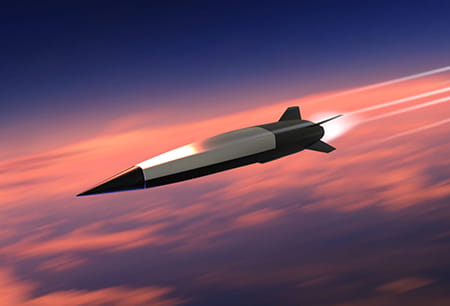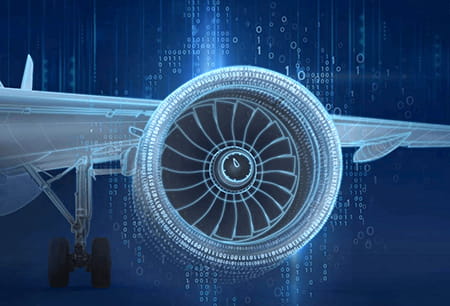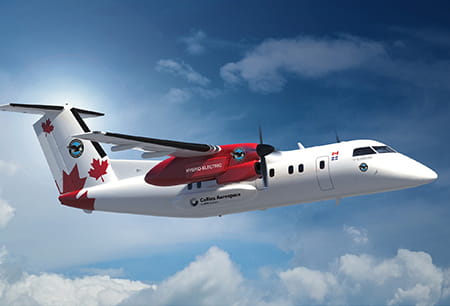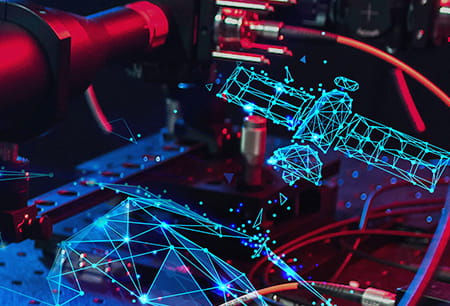85%
of the staff hold advanced degrees
In a laboratory, under the glow of blue and green lights, a piece of metal speckled with spray paint rests between two clamps.
Those clamps are part of a machine that pushes and pulls materials to test their strength. The lights help cameras capture it all, fixating on the specks of paint and measuring how different forms of stress change the distance between them.
This is what it looks like to test high-entropy alloys, or specialized materials that combine desirable properties from multiple metallic elements.
In this demonstration, the metal between the clamps was an ordinary piece of aluminum. But soon it will be something far less common: a brand-new blend whose recipe was suggested by artificial intelligence.
Scientists at the RTX Technology Research Center have tasked AI with scanning decades’ worth of research in materials science and suggesting new alloys from more than 600 billion possible combinations. It is part of their quest to find stronger, lighter and more heat-resistant metals for various uses across aerospace and defense.
“It’s impractical to approach this problem through making and testing every single one of those combinations,” said project co-lead and material scientist Ryan Deacon, “so we’re addressing this through artificial intelligence and machine learning to allow models to explore potential candidates and suggest those that are worth testing.”
High-entropy alloys could be used to make aircraft lighter or engines that run at higher temperatures – both of which would help the aerospace industry emit less carbon and burn less fuel as the industry moves toward its goal of net-zero carbon emissions by 2050.
Creating a new high-entropy alloy using traditional methods can take more than a decade, said Soumalya Sarkar, a project co-lead and data scientist who built the digital program.
“We’re trying to reduce the development cycle to just a few years,” Sarkar said, “and with machine learning, we think we can do that.”
AI and machine learning can guide their search and allow them to make more informed decisions about where to start testing, and every test they do feeds results back into the program so its recommendations improve over time. Once Sarkar’s framework suggests an alloy, Deacon creates a sample in his lab then sends it to engineers Matt Mordasky and Chris Negri to test.
Their lab, with its fusion of data and physical science, is among dozens at the center – where researchers from many disciplines work together to solve the toughest problems in aerospace and defense.
“We do the hard stuff,” said Andreas Roelofs, the center’s director, “and what we do also makes the planet better and the world safer."
The center, located in East Hartford, Connecticut, began in 1929 as part of the Pratt & Whitney Aircraft Company. Since then, it’s added a smaller campus in Berkeley, California, and served as a hub of innovation for products and services.
Each year over the past several years, the center’s researchers, on average, have been named on more than 175 U.S. patents; many of these inventions are also filed and granted as patents in other parts of the world. The researchers also represent more than 30 countries, which underscores that the center – like RTX itself – attracts talent from all over the world.
They’re adapting electrical power to propel planes, reduce their carbon emissions and advance toward sustainable commercial aviation. They’re developing trustworthy artificial intelligence that will advise military commanders, civil aviation authorities and severe-weather responders who must make fast and critical decisions.
They’re using heat exchangers to keep electronics and engines cooler, optimizing their performance and giving rise to new generations of commercial jets, military aircraft, radar systems, high-performance computers and other technologies that are core to the future of aerospace and defense.
Below, learn about two more labs finding solutions at the RTX Technology Research Center.
of the staff hold advanced degrees
hold doctorate degrees
U.S. patents secured every year on average
countries represented by RTRC researchers
For about 150 years, electric motors have worked roughly the same way: A rotor and stator work together to produce torque. Jagadeesh Tangudu and Kimberly Saviers believe it’s time to improve that design to enable electrified passenger aircraft.
For two years, the RTRC team has been working on a project called ULTRA-COMPACT, which will develop a motor that will use electrified propulsion to fly single-aisle regional aircraft like the De Havilland Canada Dash 8. That motor is similar to those in electric cars, but with a significant added challenge: In order to fly, it has to be much smaller and lighter without sacrificing power.
“Technology that works on the ground doesn’t necessarily work at 40,000 feet altitude,” Tangudu said. “We’re trying to miniaturize things to make them more efficient and power-dense.”
They’re re-imagining the motor architecture, motor-drive system, gearbox and thermal management system. Other teams have worked on improving these components separately for decades, but the RTRC team has a unique approach that customizes each component and develops them as an integrated system.
Their design focuses on four main innovations.
The first has to do with the rotor (the part that spins), the stator (the part that is stationary), and the electromagnetic interaction between them.
Rather than the traditional configuration of one rotor and one stator, this motor has three rotors and one stator. The reason: The system’s magnetic field interacts through increased surface area between the rotors and stator to produce more of the rotational force known as torque. The design also gives a new role to the copper end windings in the stator. This portion of the windings traditionally had only one job – to conduct electricity. In the new design, it is also used to produce torque and further boost the motor’s output.
The second and third major characteristics of their design make the motor more compact. Rather than placing the gearbox near the propeller, for example, they’ve included it within the motor hub itself, and they designed a motor drive that is both smaller and more efficient at converting power.
Finally, their stator has an integrated cooling system, which will allow the motor to produce more power without overheating. They constructed the cooling channels with additive manufacturing methods, and they use a novel approach to cool the system by evaporation of an environmentally-friendly refrigerant. As with many components in the system, the cooling channels serve a dual purpose also acting as the main structural support for the stator.
“If we take one of these technologies by itself, yes, it will have an impact on our overall system, but we really reap most of the rewards from exploiting all the different technologies and integrating them all together in a very multidisciplinary fashion,” Saviers said.
They estimate their technology to be about a third of the weight of the most advanced solutions available today. The team is confident their work will mark a significant step forward in electrified aviation – a concept that will be crucial in the industry’s effort to reduce its impact on climate change.
“Ultimately, the goal is to reduce the carbon footprint and increase sustainability. We all live on this planet, and we want to reduce our lasting impact for future generations,” she said. “This technology will enable us to do that.”
The information, data, or work presented herein was funded in part by the Advanced Research Projects Agency-Energy (ARPA-E), U.S. Department of Energy, under Award Number DE-AR0001351. The views and opinions of authors expressed herein do not necessarily state or reflect those of the United States Government or any agency thereof.
The controller in Ben Bedard’s hands looks like anything but a welding tool. But today, that’s exactly what it is.
On the right, there’s a thumb stick that can control the robotic arm in front of him. On the left, a screen displays the programming code the robot is following. And at the moment, that code is telling it to glide over a thin, curved structure, and apply heat that will cause its pieces to join together.
Someday that robot will be able to weld on its own, but for now it runs in manual mode, using a process invented by Bedard and his teammates Wenping Zhao and John Gangloff to help factories produce aircraft parts quickly with thermoplastic composites – light, durable and recyclable synthetic materials that can be melted and solidified multiple times without degradation.
Aircraft manufacturers want to use those materials to make next generation aircraft lighter, more fuel efficient and more sustainable. Meeting that demand requires faster methods of production.
“This robotic automation will enable a solution to rapidly manufacture materials to provide high quality, lightweight parts for the aircraft industry,” Zhao said.
Collins Aerospace, an RTX business, estimates thermoplastics can reduce the weight of aircraft structures by 20 to 50 percent when they replace metals and thermosets, a less flexible type of material that cannot be welded. The company produces more than 2,000 thermoplastic parts for fuselages, doors, wings and flight control surfaces, but with automated welding processes, it could produce larger, more complex structures.
“Using mechanical fasteners to join aircraft assemblies usually takes hundreds of fasteners – it’s time consuming. It’s higher weight,” Zhao said. “However, this technology will require no fasteners. We just weld the parts directly to each other, creating a lightweight solution.”
The system can be tailored to a manufacturing facility’s specific needs, the robot has multiple joints for a wide range of motion, and it can reliably repeat its process for quality control.
“We’re able to leverage the flexibility of the robot to reach into geometries or exert forces where a human operator may not have been able to, or even to run the welding processes to exert heat that a human operator wouldn’t necessarily be able to tolerate,” Bedard said. “The robotic arm gives us a lot of flexibility to deal with whatever the business units ask us to work on.”
In Bedard’s test, he programmed the robot to weld a piece that simulates a fan cowl, a curved covering for an aircraft engine. Fan cowls today work a little like a camping tent, with a frame that supports the outer layer. But with a rapidly welded thermoplastic fan cowl, the team joins the outer layer, frame and connectors to reduce weight and assembly time. Ordinarily, creating one would require a large, energy-intensive and costly autoclave process, but the robotic welder bypasses those problems.
“We’re thinking it’s going to streamline the logistics of these panels. If we can reduce it from a singular piece that is challenging to move around into a bunch of disparate pieces that can be joined through a series of joining processes, we can streamline that process quite a lot,” Bedard said. “I think that’ll increase the viability of thermoplastics in areas where they might not have been used previously.”
Research was sponsored by the ARM (Advanced Robotics for Manufacturing) Institute through a grant from the Office of the Secretary of Defense and was accomplished under Agreement Number W911NF-77- 3-0004. The views and conclusions contained in this document are those of the authors and should not be interpreted as representing the official policies, either expressed or implied, of the Office of the Secretary of Defense or the U.S. Government. The U.S. Government is authorized to reproduce and distribute reprints for Government purposes notwithstanding any copyright notation herein.
For 95 years the RTX Technology Research Center has operated as a multidisciplinary group of experts collaborating on groundbreaking innovations. While we respond to a wide range of challenges from across our organization, we are primarily focused on six major areas of research that are aligned to RTX’s company-wide technology strategy and road maps.

Creating disruptive product offerings through advanced system design and engineering toolsets

Developing innovative materials and fabrication methods for performance-critical applications

Digitally linking processes to enhance collaboration and improve efficiencies across the product life cycle

Fusing methods characteristic of human intelligence with sensing and processing technologies to address RTX-relevant challenges

Revolutionizing electric and alternative fuel system architectures that will power next-gen air vehicles

Driving groundbreaking innovations that feed the pipeline of transformative technologies